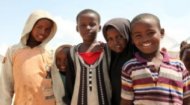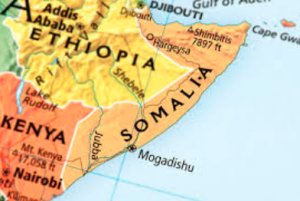|
The arrival of European powers in the late 19th century ushered in the colonial era, with Italy eventually establishing control over what became Italian Somaliland. The city was leased to Italy in 1892 who went on to actually buy Mogadishu in its entirety thirteen years later establishing Mogadishu as the new territory's administrative capital. Following the First World War, thousands of Italians moved to Mogadishu and a modern building program started in the 1930s accompanied by the assimilation of many Somalis into the city culture. By the end of that decade, some 10,000 Italian Somalians were living in Mogadishu and the city continued to thrive under Italian rule until it fell to the British, who were operating out of Kenya, on February 26, 1941 during the Second World War. Post-independence in 1960, Mogadishu briefly savoured a period of relative peace and prosperity, consolidating its position as a burgeoning modern African city. However, the promise of self-governance gradually eroded, leading to a military coup in 1969 and a subsequent descent into authoritarian rule.
Despite UN intervention, Mogadishu was then effectively ruled by warlords until 2006 when the Islamic Courts Union (left) took control. Later in 2006 Ethiopian forces swept into the country ousting the ICU and restored the former government which had been in exile in Kenya. Since 2011, with the intervention of African Union forces (AMISOM, now ATMIS) and the gradual re-establishment of a federal government, Mogadishu has embarked on a slow, arduous path to recovery. While security remains a paramount concern, the past decade has witnessed remarkable progress in rebuilding infrastructure, re-establishing governance, and rekindling hope among its resilient populace. Despite the scars of conflict, the social fabric of Mogadishu remains remarkably vibrant and complex. Its population, estimated to be well over two million, is predominantly young, dynamic, and deeply religious, adhering largely to Sunni Islam. Clan identity, while often a source of past conflict, also serves as a crucial social safety net, providing support and community bonds in the absence of robust state institutions. The city is a melting pot of various Somali clans and sub-clans, each contributing to its unique cultural mosaic. Education, severely hampered during the conflict, is slowly being rebuilt through private initiatives and the dedication of local communities. Schools and universities, often funded by the diaspora, are seeing a resurgence in enrollment, particularly among the youth who crave a better future. Healthcare, though still rudimentary in many areas, is also improving, with new clinics and hospitals providing essential services.
The economic lifeblood of Mogadishu pulses through its strategic port, which serves as Somalia's main gateway for imports and exports. The port handles a significant volume of goods, from food and construction materials to vehicles, serving not only Somalia but also landlocked Ethiopia. Its rehabilitation and modernisation are crucial for the country's broader economic recovery. However, the formal economy remains nascent and faces significant hurdles. A vast majority of economic activity occurs in the informal sector, driven by small businesses, street vendors, and the ubiquitous mobile money transfer system (Xawila), which handles billions of dollars annually in remittances from the diaspora. These remittances are a lifeline for countless families, funding everything from daily expenses to the construction of new homes and businesses. Construction is perhaps the most visible sign of Mogadishu's economic resurgence. New buildings are mushrooming across the city, driven by returning diaspora members investing their savings and local entrepreneurs. The service sector is also growing, with hotels, restaurants, and various small enterprises catering to the needs of a slowly recovering population and international aid workers. Livestock, charcoal, and frankincense remain key export commodities, though issues of sustainable management and illegal trade persist. |
Mogadishu Profile |
Mogadishu Profile |
Mogadishu Profile | Mogadishu Profile |
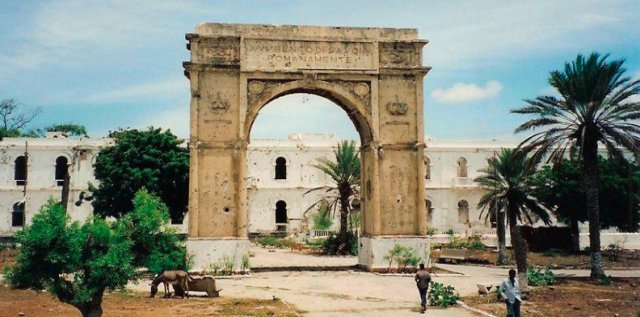
|
Despite these positive developments, the economy faces severe challenges. High unemployment, particularly among the youth, is a critical issue that makes young people vulnerable to recruitment by extremist groups. Lack of access to formal banking, limited foreign direct investment due to security concerns, inadequate infrastructure (electricity, reliable water supply), and pervasive corruption further hinder sustainable growth. The government is striving to create an enabling environment for investment, but progress is slow and arduous. Mogadishu's journey towards stability is fraught with persistent challenges. The primary concern remains security. Al-Shabaab, though weakened, continues to launch deadly attacks, including suicide bombings and assassinations, targeting government installations, hotels, and public places. These acts undermine public confidence, deter investment, and disrupt daily life. The ongoing efforts of the Somali security forces and ATMIS are crucial in combating this threat, but a long-term solution requires addressing the root causes of extremism, including poverty and lack of opportunities. Governance and the rule of law are other significant hurdles. Decades of conflict have left institutions weak and susceptible to corruption. Building a stable, transparent, and accountable government that can deliver essential services to its citizens is a monumental task. This includes developing a functioning justice system, strengthening administrative capacity, and ensuring equitable resource distribution. Infrastructure is still severely underdeveloped. While some roads have been paved and the electricity supply has improved in certain areas, large parts of the city lack basic amenities like reliable power, clean water, and sanitation systems. This impacts public health, restricts economic activity, and lowers the overall quality of daily life. Finally, humanitarian challenges persist. Mogadishu hosts a large number of internally displaced persons (IDPs) who have fled conflict or climate-induced disasters like droughts and floods. These communities live in precarious conditions, dependent on aid, and are highly vulnerable. Food insecurity, limited access to healthcare, and the recurring impacts of climate change continue to test the city's resilience. Despite this, the city's youth are increasingly engaged in civic life, innovation, and entrepreneurship, leveraging technology to connect with the world and build a better future. The substantial contributions of the diaspora, not just in remittances but also in expertise and investment, are vital for its ongoing transformation. Daily life in Mogadishu is a testament to the extraordinary resilience of its people. Amidst the ever-present security concerns, a sense of normalcy prevails. Bustling markets, like the famous Bakara Market, pulsate with activity, offering everything from fresh produce and livestock to electronics and clothing. The market was recommended by one traveler if only on the grounds, "I didn't get stabbed". The aroma of Somali spices mingles with the cacophony of commerce, as vendors call out their wares and shoppers haggle for the best prices. Tea shops, known as 'shaahanyo,' are ubiquitous, serving as informal community hubs where men gather to discuss politics, family, and the latest news over sweet, spiced tea. Should you find yourself in Mogadishu, a trip to the beach, originally made for Italian colonialists, is a must if only to escape the heat. There you can mingle with the many thousands who congregate next to the warm Indian waters enjoying its beachfront resorts. Also worth a look is The Black Hawk Down Crash Site museum, being a major attraction for limited American visitors, as well as the Governor's House, the Union Mosque, Mogadishu Cathedral (built by the Italians during the colonial period) and the Tomb of the Unknown Soldier, a monument with so many unknowns it's not even known what battle he died in. or she. Or when.
|
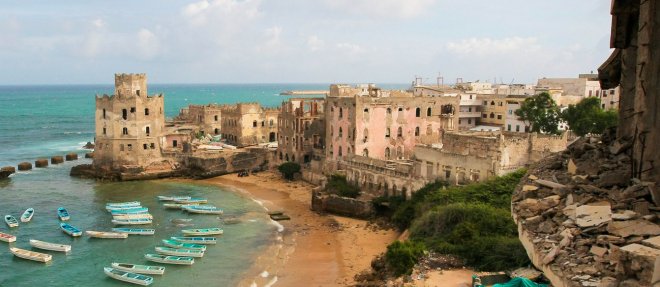
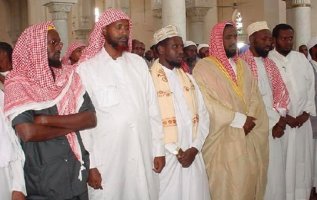 The true turning point, and the beginning of its most formidable challenges, after rebel forces took the city in 1990 forcing the president of Somalia to flee to Kenya the following year. Mogadishu became the epicentre of a brutal civil war, fractured by clan-based militias and warlords. The conflict decimated infrastructure, displaced millions, and earned the city a reputation as one of the world's most dangerous places. The iconic images of 'Black Hawk Down' in 1993 became synonymous with the city's grim reality. For two decades, Mogadishu endured constant shelling, lawlessness, and the rise of extremist groups like Al-Shabaab, which sought to impose their rigid ideology and control.
The true turning point, and the beginning of its most formidable challenges, after rebel forces took the city in 1990 forcing the president of Somalia to flee to Kenya the following year. Mogadishu became the epicentre of a brutal civil war, fractured by clan-based militias and warlords. The conflict decimated infrastructure, displaced millions, and earned the city a reputation as one of the world's most dangerous places. The iconic images of 'Black Hawk Down' in 1993 became synonymous with the city's grim reality. For two decades, Mogadishu endured constant shelling, lawlessness, and the rise of extremist groups like Al-Shabaab, which sought to impose their rigid ideology and control. Culturally, Mogadishu maintains its rich heritage. Oral poetry, a cornerstone of Somali culture, thrives, as do traditional music and dance. Mobile phones and social media have become vital tools for communication, information sharing, and connecting with the vast Somali diaspora scattered across the globe, who play a significant role in remitting funds that fuel the local economy. Despite the difficulties, there's a palpable sense of hope and determination that permeates the city, particularly among its youth, who are eager to embrace opportunities and forge a new narrative for their homeland.
Culturally, Mogadishu maintains its rich heritage. Oral poetry, a cornerstone of Somali culture, thrives, as do traditional music and dance. Mobile phones and social media have become vital tools for communication, information sharing, and connecting with the vast Somali diaspora scattered across the globe, who play a significant role in remitting funds that fuel the local economy. Despite the difficulties, there's a palpable sense of hope and determination that permeates the city, particularly among its youth, who are eager to embrace opportunities and forge a new narrative for their homeland.